By Karen Blakey and Richard J. Q. McNally
Since their introduction in the United States in the 1940s, artificial fluoridation programmes have been credited with reducing tooth decay, particularly in deprived areas. They are acknowledged by the US Centers for Disease Control and Prevention as one of the ten great public health achievements of the 20th century (alongside vaccination and the recognition of tobacco use as a health hazard). Such plaudits however, have only gone on to fuel what is an extremely polarised ‘water fight’. Those opposed to artificial fluoridation continue to claim it causes a range of health conditions and diseases such as reduced IQ in children, reduced thyroid function, and increased risk of bone cancer. Regardless of the controversy, the one thing that everyone agrees upon is that little or no high quality research is available to confirm or refute any public concerns. The York systematic review of water fluoridation has previously highlighted the weakness of the evidence base by acknowledging the quality of the research included in the review was low to moderate.
Fluoride changes the structure of tooth enamel making it more resistant to acid attack and can reduce the incidence of tooth decay. This is why it is added to drinking water as part of artificial fluoridation programmes. The aim is to dose naturally occurring fluoride to a level that provides optimum benefit for the prevention of dental caries. The optimum range can depend on temperature but falls within the range of 0.7-1.2 parts per million (ppm) for Great Britain. Levels lower than 0.7ppm are considered to provide little or no benefit. Drinking water standards are set so that the level of fluoride must not exceed 1.5ppm in accordance with national regulations that come directly from EU law.

Severn Trent Water, Northumbrian Water, South Staffordshire Water, United Utilities, and Anglian Water are the only water companies in Great Britain that artificially fluoridate their water supply to a target level of 1 ppm. The legal agreements to fluoridate currently sit with the Secretary of State, acting through Public Health England, although local authorities are the ultimate decision makers when it comes to establishing, maintaining, adjusting or terminating artificial fluoridation programmes. As a programme dedicated to improving oral health, all of the associated costs come from the public health budget. Therefore, it is important to know that the money is being spent in the most effective way.
Our study has, for the first time, enabled an in-depth examination of the relationship between the incidence of two of the most common types of bone cancer that are found in children and young adults, osteosarcoma and Ewing sarcoma, and fluoride levels in drinking water across the whole of Great Britain. We have combined case data from population based cancer registries, fluoride monitoring data from water companies and census data within a computerised geographic information system, to enable us to carry out sophisticated geo-statistical analyses.
The study found no evidence of an association between fluoride in drinking water and osteosarcoma or Ewing sarcoma. The study also found no evidence that those who lived in an area of Great Britain with artificially fluoridated drinking water, or who were supplied with drinking water containing naturally occurring fluoride at a level within the optimal range, were at an increased risk of osteosarcoma or Ewing sarcoma.
It is important to note that finding no evidence of an association between the geographical occurrences of osteosarcoma or Ewing sarcoma and fluoride levels in drinking water, does not necessarily mean there is no association. Indeed, intake of fluids and food products that contain fluoride will not be the same for everyone and not taking this variation into consideration is one of the limitations of our study. Nevertheless, the methodologies we have developed could be used in the future to examine fluoride exposure over time and take other risk factors into consideration at an individual level. Such an approach could help the controversy surrounding artificial fluoridation ebb rather than flow.
Another important, although unexpected, finding arose from our use of fluoride monitoring data. We found that the fluoridation levels of approximately one third of the artificially fluoridated water supply zones were below 0.7ppm (the minimum limit of the optimum range). This finding reinforces that it is incorrect to assume an artificially fluoridated area is dosed up to 1ppm. In reality, it may be a lot less. A number of previous studies have mistakenly made this assumption making their conclusions unreliable. Our study shows that you cannot guarantee that fluoride levels in all artificially fluoridated water supply zones are close to the target level of 1ppm. Assuming that water fluoridation is a safe practice and evidence surrounding calculation of recommended dosage is reliable, this finding has economic implications in terms of public health. If public money is paying for artificial fluoridation shouldn’t the water supply zones be dosed up to a level that will provide the greatest benefit? If they aren’t then could it be that public money is merely being thrown down the drain?
Karen Blakey is a Research Assistant at the Institute of Health & Society, Newcastle University. She is interested in geographical information systems and the spatial analysis of disease registry data. Richard J.Q. McNally is a Reader in Epidemiology at the Institute of Health & Society, Newcastle University. He is interested in spatial epidemiology, the epidemiology of chronic diseases and the statistical analysis of registry data. They are authors of the paper ‘Is fluoride a risk factor for bone cancer? Small area analysis of osteosarcoma and Ewing sarcoma diagnosed among 0-49-year-olds in Great Britain, 1980-2005’, which is published in the International Journal of Epidemiology.
The International Journal of Epidemiology is an essential requirement for anyone who needs to keep up to date with epidemiological advances and new developments throughout the world. It encourages communication among those engaged in the research, teaching, and application of epidemiology of both communicable and non-communicable disease, including research into health services and medical care.
Subscribe to the OUPblog via email or RSS.
Subscribe to only health and medicine articles on the OUPblog via email or RSS.
Image credit: Glass half full. By Jenny Downing. CC-BY-2.0 via Wikimedia Commons
The post Fluoridation of drinking water supplies: tapping into the debate appeared first on OUPblog.

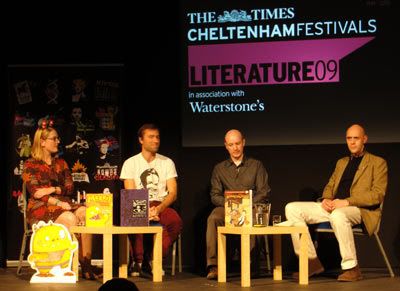
Stuart and I decided to make a holiday weekend of our trip to the Cheltenham Literature Festival, and our friend Garen Ewing was on the same panel with me, and brought along his wife Ellie, so we had a great time. On the panel, I got to meet writer of the graphic novel Salem Brownstone, John Dunning and the slightly shy but very lovely and funny host, Kieren Phelps (who'd just a couple nights previously been presenting the annual Cheltenham Illustration Awards, where Simone Lia and Tom Gauld had given the keynote speech.) Here's a link to Garen's write-up of the event.
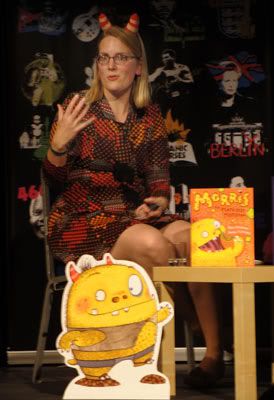
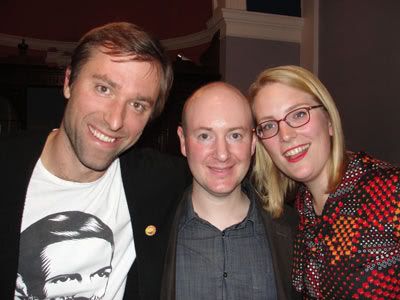
I felt a little funny plugging a picture book when the panel was about graphic novels, but I showed a lot of my comics work, including my Vern and Lettuce strip for The DFC. Most of the audience questions were about making their own comics: how to get their comics published, Photoshop techniques, whether it's possible to make a career of making comics, etc. I briefly mentioned my studio and when I said I shared with Gary Northfield, the guy who creates Derek the Sheep for the the Beano, I saw a kid in the front row jump about a foot and suddenly he was all ears, heh heh.
The great thing about literary festivals is that you never know who you're going to run into. I got to meet the usually elusive Lucy Cousins, creator of the beautiful and boldly graphic Maisie books:
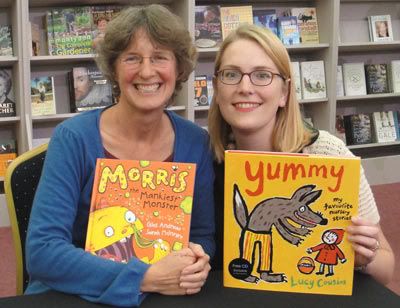

Lucy Cousins & me with our books; Maisie in the kids storytelling tent
I had a couple of my own Morris the Mankiest Monster books in my handbag, and I ended up giving one to Lucy and one to Cherie Blair, who was waiting with me in the Writer's Room before our talks. Cherie said, 'oh yes, Giles is the Purple Ronnie guy!' and went through the whole book, laughing, then blanching at the page where Morris looks at the potatoes growing out of his pants. She was really nice, I hope her talk went well.
Stuart picked a couple talks for us to go to, so we went to a panel about spooks and spying which included Stella Rimington, the person who held the real job behind the character of James Bond's 'M'. I was slightly annoyed at the academic dude on her left who kept interrupting her, but it was great to hear her talk. Just a background note, I met Stuart while he was working for the British Embassy in Moscow, so we're familiar with a lot of the places and job positions that often come up in spy novels.
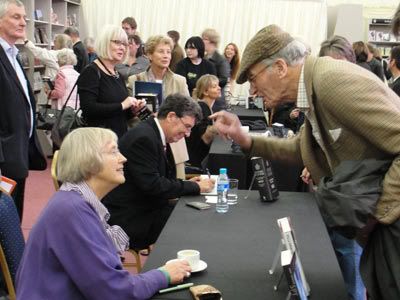
Stella Rimington at the signing table; you can just see writer Kate Mosse, the seated blond in the background
We also got to hear a great talk by John Irving about his latest novel, Last Night in a Twisted River, and about the discipline of writing. He talks a lot like my dad, taking a long time to pause and think after each question, and answering in a somewhat pedantic way but delivering lots of thoughtful insight. He talked about how he likes to work backward when he writes, getting a very solid idea about the book's ending, then figuring out how far back the book should start. I took loads of notes, so ask me if you ever want to know more about what he said, but one thing that made me laugh was when he said, When you start writing, the piece of paper doesn't know who you are; the paper is unimpressed. Heh heh, even John Irving gets the Terror of the Blank Page.

John Irving
I went into one of the tents to try out the new Sony Readers. Still not convinced I want one, but I had loads of fun drawing alien graffiti on Hitchhiker's Guide to the Galaxy and drinking their free hot chocolate.

We crashed at lunch time in the refreshments tent and Stuart read the paper while I drew monsters with the kids at our table:


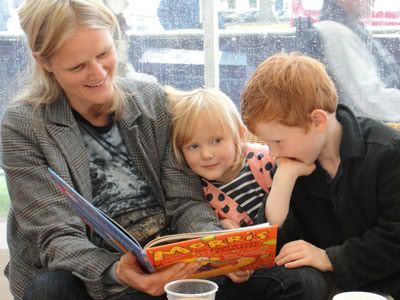
They had fun reading through Morris and being grossed out in all the right places. The girl made a fun mucky mess of the table with some rain water she and her brother had collected from one of the fountains, then I got to meet their dad, a Times features writer named Damian Whitworth, who introduced us to his friend, Times journalist Ben Macintyre, someone I've always been a bit curious about because of his last name.
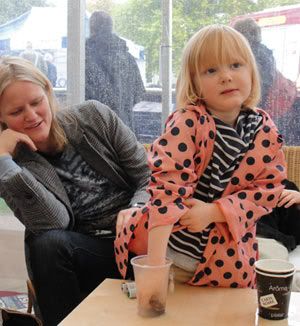
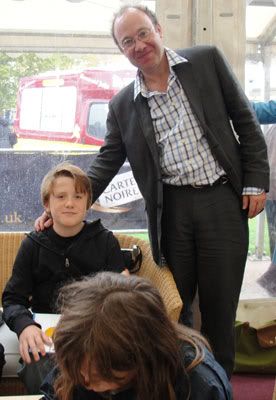
After our event on the first day, we went out to celebrate Ellie's birthday with a dinner at an ornately decorated Thai restaurant.
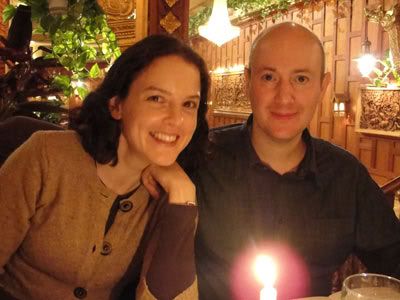
Ellie and Garen Ewing
I almost ordered this dish because it seemed very in keeping with the manky Morris theme:

We had lots of veggies carved as flowers and now that I'm an adult, I'm allowed to play with my food:
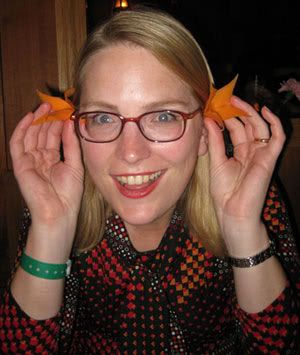
Here's a nice photo of which my mother will approve:
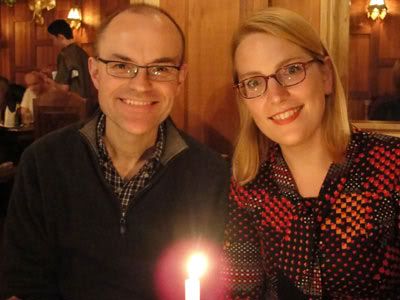
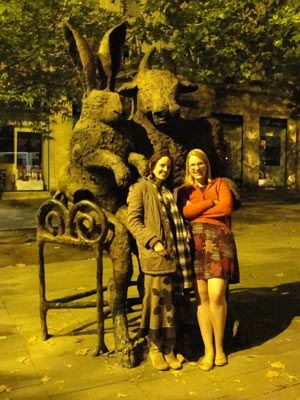
The other pic is Ellie and me posing next to Cheltenham's rabbit and minotaur, which at night-time look like something out of Donnie Darko.
We went on a walk around town before heading off; it was great to see someone's taken on the DFC and given it new life:

And we popped into the Cheltenham Art Gallery & Museum and saw this fabulous, macabre chimney sweep:
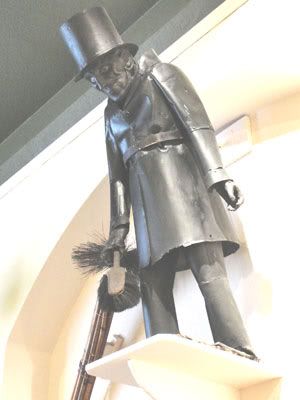
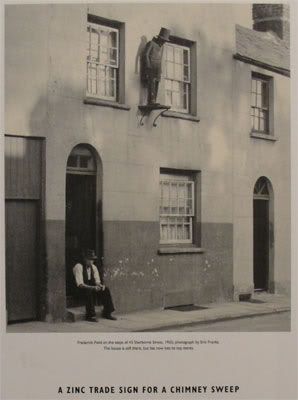
And didn't hang around long enough to find out how to become friends of the local Pig Insurance society, maybe next time.
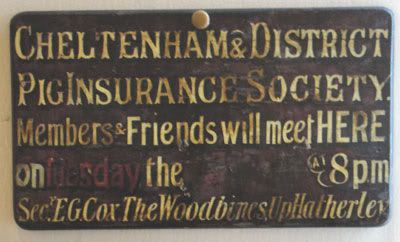
And a last one of Stuart, the star of our show...

Thanks, all your people who made this festival happen!

Today Vern and Lettuce met up for a quiet little comics office party, while Garen, Dave, Ellen and I went streaking through the streets of Brixton.
... Ha ha, no, the other way round (shame, that). The DFC Christmas double issue is HERE! And it looks fab!!! You can get lots of little peeks at it on the DFC website! Gary Northfield's Little Cutie gets a full double-page spread, and you can read a newly posted interview of Gary on Anna Mondo's blog. Ooh, and another one with Gary about Derek the Sheep on the Forbidden Planet blog.

And the other exciting thing today, I got to try quince jam! The reason this is exciting is that it was one of my four goals of things I wanted to do in England, the other three being animal sightings. (Seen a meadow lark, still need to see a live hedgehog and a badger.)
Here I am eating Ellen's mother-in-law's quince jam with hot scones in Ellen's kitchen:

And here is our office party at a fab little pizza place in Brixton market:

(![[info]](http://p-stat.livejournal.com/img/userinfo.gif) tozocomic,
tozocomic, ![[info]](http://p-stat.livejournal.com/img/userinfo.gif) rainboworchid and
rainboworchid and ![[info]](http://p-stat.livejournal.com/img/userinfo.gif) ellenlindner)
ellenlindner)
For our Secret Santa gifts, we all made 2"x 2" drawings and I got Dave's! Ellen kindly models with it here:
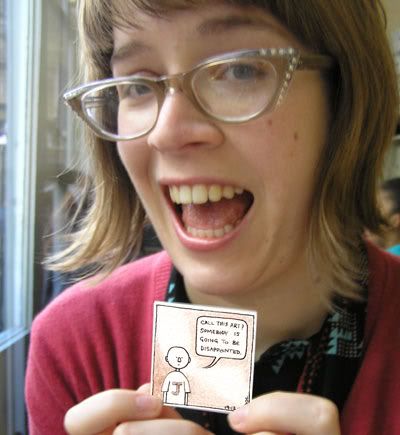
Edit: You can see my little art piece on Garen's blog here!
And one last thing, this morning I saw a mysterious message scrawled onto the pavement next to my post office. Whatever can it mean?

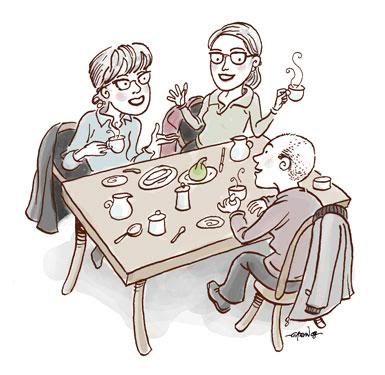
Hooray! Garen Ewing just posted this drawing on his blog! It was great to see him and Ellen Lindner during my day in central London on Wednesday (even if that funny-looking little green pastry turned out to cost a fiver). I'm really looking forward to Garen's upcoming work in the DFC, Charlie Jefferson and the Tomb of Nazaleod. Have you seen Ellen's latest book, Little Rock Nine? It's well worth reading, and she's currently working on another comic of E.M. Forster's short story, The Machine Stops. You can read her amazing novel Undertow online here.
It's funny, when you get a bunch of comics people together, we always have to get out pens and paper to draw things when we have difficulty describing them. I particularly liked this picture Ellen drew in my notebook during a discussion of historic genetic oddities of the Spanish royal family. (Although I think this must be one of the better looking monarchs.)

I'm off to the SCBWI conference in Winchester today, where in my workshop I'll be giving a first peek at layouts for the picture book I'm illustrating for David Fickling, written by Britain's best-selling contemporary poet, Giles Andreae.
I'll be back in London on Sunday morning for the panel at the ICA with DFC colleagues Adam Brockbank, John and Patrice Aggs and Gary Northfield. Speaking of which, have you been following Adam Brockbank's DFC strip with Ben Haggarty, Mezolith? It's just getting better and better, and I was totally amazed by his swan maidens and the big earth woman in the last couple episodes.
Don't forget, you can buy the DFC in Tesco from 26 Nov - 2nd Dec. (John Freeman comments on the DFC in Tesco here.) But you can also buy single issues at any time from the DFC website.


































